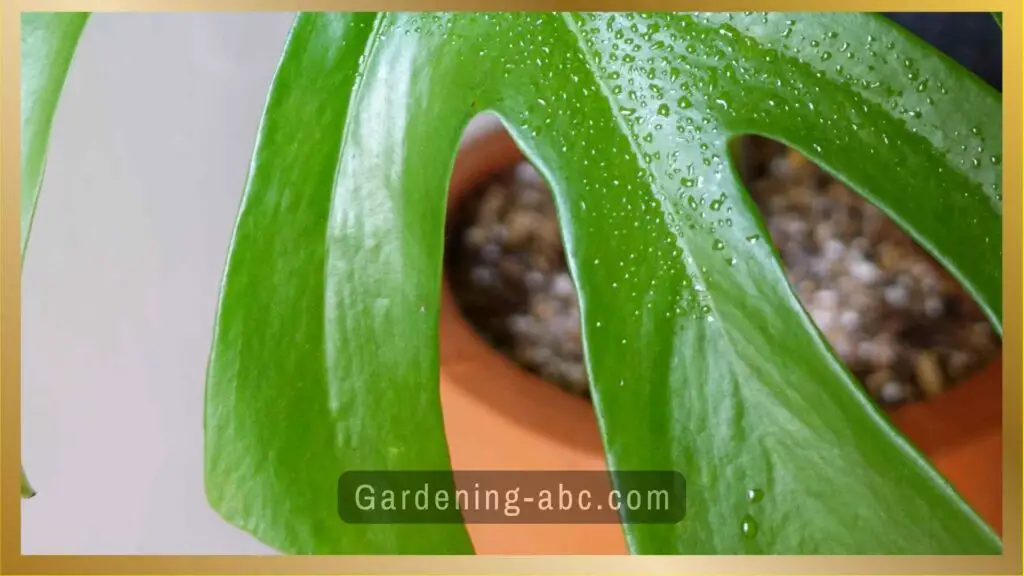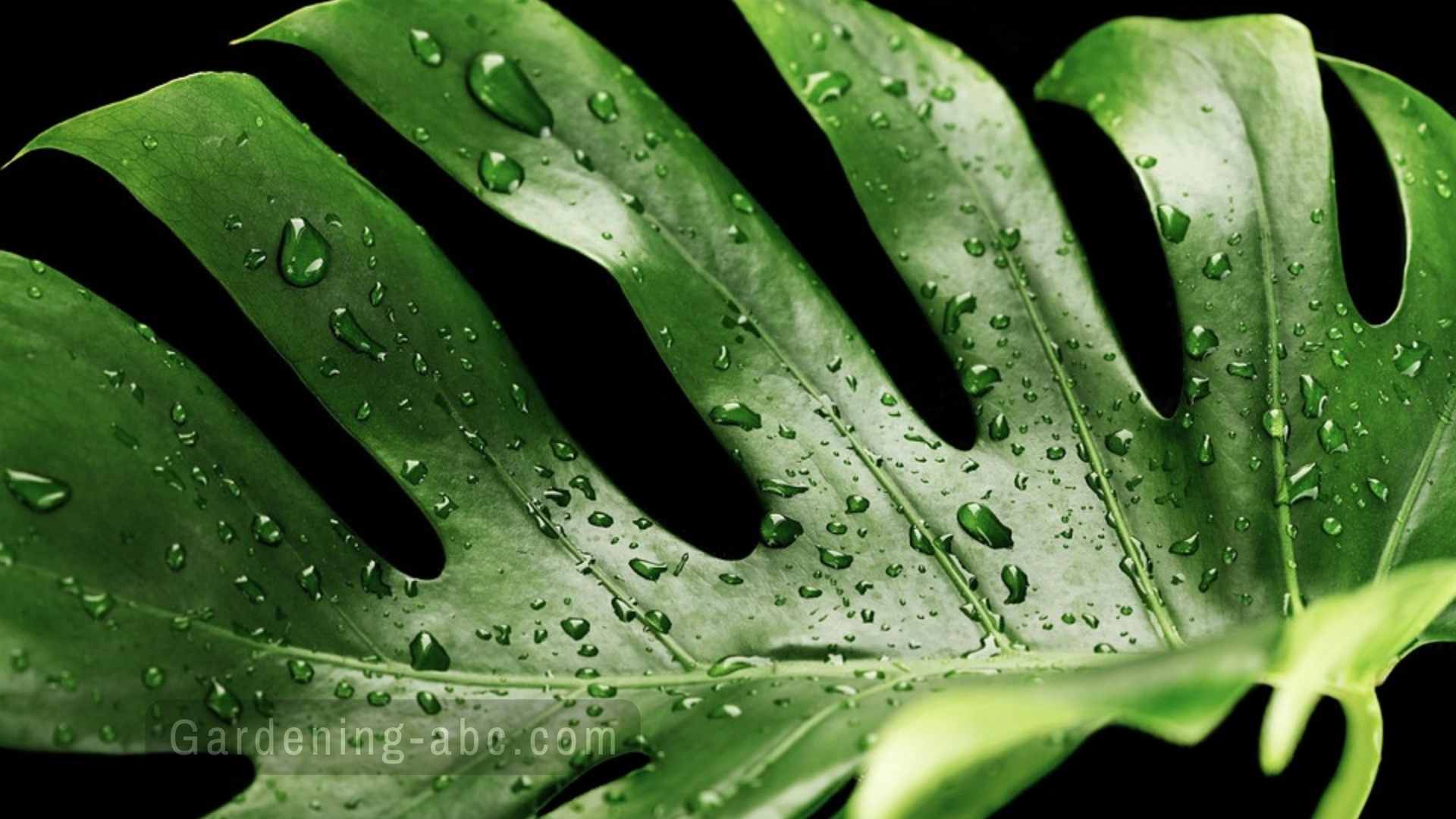We use affiliate links to run our site. When you buy through links on our site, we may earn an affiliate commission, without any added cost to you. Learn more
Do you want to experience the joy of bringing the lush greenery of a tropical jungle into your home? If so, get ready to meet the Monstera deliciosa, the plant that will steal your heart and transform your space.
Its striking, holey leaves have captured the hearts of plant lovers everywhere, and it’s not hard to see why. But while the Monstera deliciosa is a beautiful and captivating plant, it can be a bit of a diva when it comes to its care.
If you’re up for the challenge, we’re here to guide you through everything you need to know to keep your Monstera deliciosa thriving. From soil and watering to light and humidity, we’ll cover all the essential care tips and tricks so you can ensure your plant remains a vibrant centerpiece in your home.
So, let’s dive into the world of Monstera deliciosa and discover how to make your indoor jungle dreams a reality!
Getting Started: Understanding Your Monstera deliciosa
Are you ready to embark on a thrilling journey of growing your very own swiss cheese plant? Before you get your hands dirty, it’s crucial to understand this plant’s unique characteristics.
Hailing from Central and South America, this tropical vine plant belongs to the Araceae family, which includes other beloved plants such as the Philodendron and Peace Lily.
What sets the Monstera deliciosa apart is its unmistakable leaves, resembling none other than Swiss cheese! It’s no wonder that plant enthusiasts worldwide adore this unique feature, making it one of the most popular choices for indoor plants.
So let’s get started on growing your very own Monstera deliciosa and watch as those distinctive holes in the leaves add character to your space.
Types of Swiss Cheese Plants:
Swiss cheese plants are not limited to just one type! Several species bear the name of the Swiss cheese plant, each with its unique characteristics.
Let’s take a closer look at some of these amazing species:
- Monstera deliciosa: This species has larger leaves than Monstera Adansonii, and it’s a real showstopper. The size and the unique leaf pattern make it a great addition to any indoor garden.
- Monstera borsigiana: If you’re looking for a smaller Swiss Cheese Plant that is still impressive, Monstera borsigiana is the one for you. This species is faster growing than Monstera deliciosa and is perfect for those who want to fill a space quickly.
- Monstera obliqua: Rare and elusive, Monstera obliqua is a sight to behold. Its leaves are even thinner than Monstera Adansonii, but with more holes! If you’re lucky enough to get your hands on one, it will definitely be the highlight of your plant collection.

Choosing the Right Pot and Soil:
The foundation of a healthy and thriving Monstera deliciosa starts with finding the perfect pot and soil. Choosing the right pot size is essential to ensure your plant has enough room to grow and flourish.
We recommend a pot with a diameter of 6-8 inches for a young Monstera deliciosa. As the plant grows, you can always repot it into a larger pot to accommodate its size.
Now, let’s talk soil. The type of soil you choose is just as important as the pot size. Monstera thrives in well-draining soil that is rich in organic matter. This will allow the roots to absorb nutrients and water while avoiding root rot.
To create the perfect soil mix for your Swiss Cheese plant, we recommend using a combination of peat moss, perlite, and vermiculite. Peat moss is an excellent organic material that provides moisture retention, while perlite and vermiculite help improve drainage and aeration.
It’s crucial to note that using the wrong type of soil or pot can stunt the growth of your plant or even cause it to die. For example, using a pot without drainage holes can cause water to accumulate and lead to root rot while using heavy soil that doesn’t drain well can suffocate the roots.
By selecting the right pot and soil, you’re setting your Monstera deliciosa up for success. Not only will it thrive, but you’ll be able to enjoy its unique beauty and stunning foliage for years to come.
Lighting Requirements:
Light is one of the most critical factors in growing a healthy and vibrant Monstera deliciosa. These stunning plants require bright, indirect light to thrive, but direct sunlight can be harmful and cause the plant’s leaves to burn. Finding the perfect balance is essential to keep your Swiss Cheese plants happy and healthy.
So, where should you place your Monstera deliciosa? We recommend finding a location that receives bright, filtered light. This could be near a window that gets indirect sunlight or a few feet away from a bright light source, such as a lamp.
It’s essential to avoid placing your plant in direct sunlight, as this can damage the leaves and harm the plant.
But what if you notice that your Monstera isn’t growing or developing new leaves? This could be due to insufficient light.
If you find that your plant is struggling, try moving it to a brighter location or investing in a grow light. A grow light like this is an excellent option for those who don’t have access to bright, filtered light, or for those who want to give their plant a little extra boost.
Remember that lighting requirements may vary depending on the season and the location of your plant. Pay attention to your plant’s response to light and adjust accordingly.
Watering Your Monstera deliciosa:

Watering your Swiss Cheese plant may seem like a straightforward task, but it’s essential to get it right to keep your plant healthy and thriving. These beautiful plants don’t like to be overwatered, so it’s crucial to find the perfect balance.
We recommend watering your Monstera once a week, allowing the soil to dry out partially between waterings. But how do you know when it’s time to water your plant? One way to check is by sticking your finger into the soil. If the top inch of soil feels dry, it’s time to water your plant.
It’s important to avoid overwatering your Monstera deliciosa, as this can lead to root rot and ultimately, the death of your plant.
If you notice that the soil is consistently wet or that the leaves are turning yellow or brown, you may be overwatering your plant. In this case, adjust your watering schedule and allow the soil to dry out more before watering again.
Remember that the frequency of watering may vary depending on factors such as humidity, temperature, and the size of your pot. Keep an eye on your plant’s response to watering and adjust accordingly.
With a little bit of attention and care, you can ensure that your Monstera deliciosa is well-hydrated and flourishing, providing you with endless joy and beauty.
Fertilizing Your Monstera deliciosa:
Your Monstera deserves to be healthy and radiantly beautiful, and fertilizing it regularly can help achieve just that! We recommend fertilizing it every two weeks during the growing season, which spans from spring to summer, to ensure that it receives the essential nutrients it needs to thrive.
A balanced, water-soluble fertilizer is ideal for the Swiss cheese plant, as it will provide the necessary nutrients to keep it looking its best.
Don’t deprive your Monstera deliciosa of the nourishment it needs to grow into a stunning and healthy plant!
Propagation
Do you want to expand your collection of Monstera deliciosa plants without breaking the bank? The answer lies in propagating your Swiss Cheese Plant!
Not only is this a cost-effective way to get more plants, but it also allows you to put any stems you remove while pruning to good use.
The best time to propagate is in the spring when the plant is entering its growing season.
how to propagate your Monstera deliciosa plant:
Begin by trimming off a 4- to 6-inch piece of stem, cutting just after a leaf node (the node stays intact). Removing any leaves on the bottom third to half of the cutting.
Next, apply a rooting hormone to the cut end of the stem.
Plant the cutting in moistened soilless potting mix in a small container with drainage holes. Place it in a warm spot with bright, indirect light.
Continue to keep the growing medium lightly moist. In a few months, you should have well-formed roots, after which you can transfer the cutting to a larger pot.
Now you can enjoy even more of these stunning plants without spending a fortune!
Growing Swiss cheese plants from seeds:
Do you want to grow a Swiss cheese plant from seeds instead? It may take a bit of patience, but the reward is well worth it! Here’s what you need to do:
Start by filling a shallow tray with moistened seed-starting mix. Lightly cover the seeds with the growing medium and place plastic wrap over the tray to trap moisture. Don’t forget to put the tray in a warm spot with bright, indirect light.
As the seeds start to germinate in a few weeks, make sure to mist the growing medium to keep it moist.
Once the seedlings are large enough for transplanting, remove the plastic wrap and continue to keep the growing medium moist.
In just a few months, you’ll have a beautiful Swiss cheese plant that you grew from scratch!
It may take a little more effort than propagating with stem cuttings, but the satisfaction of growing from seeds is unbeatable.
Common Pests & Plant Diseases :
If you’re growing a Swiss cheese plant, you might encounter some common pests and diseases that can affect your plant’s health.
Some of the most common pests that attack this plant include mealybugs, spider mites, scale, and whitefly. These pesky critters can weaken your plant and cause leaf damage, but the good news is that they can be treated with non-toxic insecticides or neem oil.
Also, keep an eye out for common diseases that can affect your plant’s growth, such as root rot, rust, powdery mildew, and blight. Catching these issues early can help prevent further damage and keep your Swiss cheese plant thriving.
Conclusion:
Growing a Swiss cheese plant can be a truly rewarding experience for any plant lover. The unique foliage and low-maintenance nature of this plant make it an excellent addition to any indoor garden. Remember to water and fertilize with care, propagate and grow from seed with attention, and be mindful of pests and diseases.
If this post resonated with you and sparked your love for plants, please share it with your fellow plant enthusiasts. And if you’re looking for more tips and tricks on growing plants, explore our other articles on this site.
Don’t wait any longer! Take action today and start growing your own Swiss cheese plant. Nurture it with love and patience, and you’ll soon have a thriving Monstera deliciosa that will bring joy and beauty to your home.
Amazon and the Amazon logo are trademarks of Amazon.com, Inc, or its affiliates.

Hi there! My name is Prasenjit and I’m an avid gardener and someone who has grown a passion for growing plants. From my hands-on experience, I have learned what works and what doesn’t. Here I share everything I have learned.
